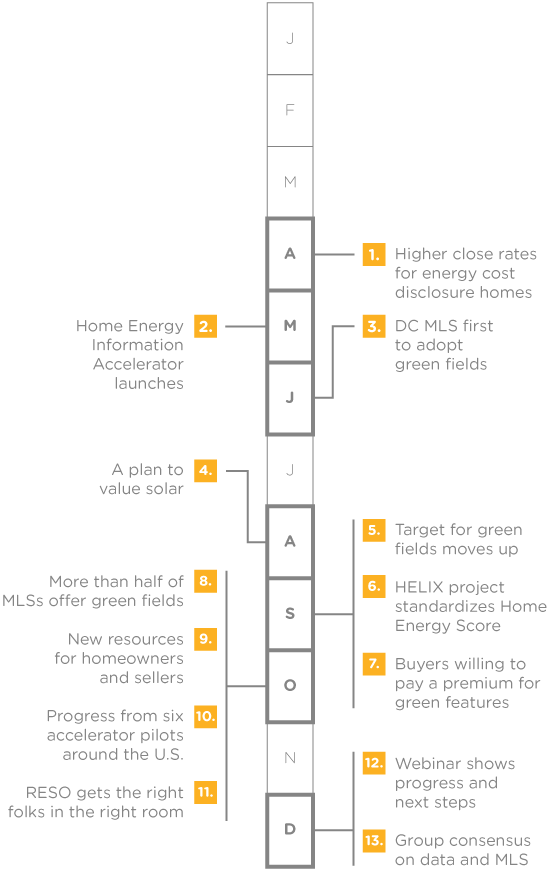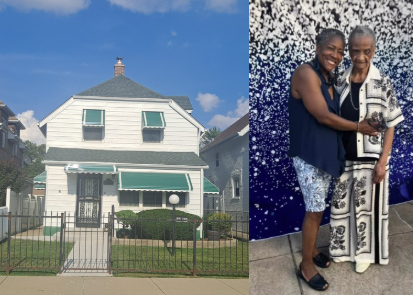Energy Efficiency, Meet Real Estate: A 2015 Year in Review and a Forecast for the Future
A lot is happening at the intersection of residential energy efficiency and real estate.
First, let us set the scene. Elevate Energy and others have long recognized a specific challenge: When homeowners invest in improving the energy efficiency of their home and property, these measures are often invisible during key steps of the home sale or refinance transaction.
It’s important to make these features visible (and to consistently document them) so that the improvements can be accurately valued when a home is sold. The result is a virtuous cycle in which homeowners are incentivized to invest in energy efficiency improvements, as they can reap the full and fair value at the time of selling a home. This is why we published the Visible Value blueprint in 2013.
A Strong Start in Early 2015
The great news is that stakeholders from the energy efficiency and real estate industries are transforming the market at key points within the multiple listing service (MLS) listing process and during appraisals. However, we recently recognized that the overall movement was lacking a central, unifying platform for collaboration. Around the same time, in early 2015, the U.S. Department of Energy’s (USDOE) Better Buildings initiative was looking to extend their successful Accelerator model to the residential space. Advocates quickly got behind the concept of an Accelerator focused on home energy information. The Home Energy Information Accelerator launched in May 2015.
A lot of great work has happened as a result. Taken together, the milestones we highlight in this timeline demonstrate real progress toward making visible value a reality. The milestones also indicate trends for 2016 and beyond, including an emphasis on “auto-population” of home energy information that embraces data standards.
 April 2015: Visible Value in Chicago’s Backyard
April 2015: Visible Value in Chicago’s Backyard
What happens when a Chicago single family real estate listing discloses residential energy costs, as part of a modernized energy cost disclosure ordinance? An analysis suggests the listing has a higher close rate and spends less time on the market. Disclosing energy costs facilitates more informed decisions by all involved in the real estate transaction, including seller, buyer, and agent.
 May 2015: USDOE Home Information Energy Information Accelerator Launches
May 2015: USDOE Home Information Energy Information Accelerator Launches
Recognizing that market transformation will require collaboration across sectors, the USDOE launches the Home Energy Information Accelerator during a meeting at the White House. Elevate Energy is a key partner involved with the initiative, which includes national organizations, federal agencies, and regional, state, and local leaders in real estate and energy efficiency.
 June 2015: Mr. Green Fields goes to Washington.
June 2015: Mr. Green Fields goes to Washington.
The Metropolitan Regional Information Systems (MRIS), the local MLS serving Washington DC, is the first to adopt green fields that are compliant with the Real Estate Standards Organization’s (RESO) Data Dictionary. The fields prove easy to use and set the stage for future milestones, notably the auto-populating of this data in the MLS.
 August 2015: But what about solar?
August 2015: But what about solar?
Lawrence Berkeley National Laboratory, Elevate Energy, and a team of national and local experts kick off a year-long effort to develop a road map for adding residential solar system information to the MLS. The goal is to define the path to auto-populate data so that these increasingly prevalent residential systems can be fairly and consistently valued. Stay tuned in 2016.
 September 2015: RESO Hits the Gas Pedal
September 2015: RESO Hits the Gas Pedal
RESO accelerated its national target for MLSs to adopt standard fields for home energy information by two years, from 2020 to 2018. This new deadline will encourage software vendors to build more standard tools and bring the capability of searching by energy efficiency characteristics to more markets. (Approximately 750 MLSs operate in different markets around the country, each with different governance models and field offerings.)
 September 2015: USDOE’s HELIX Project to Standardize Home Energy Score Data
September 2015: USDOE’s HELIX Project to Standardize Home Energy Score Data
Earlier efforts to “Green the MLS” kick-started the push for standard fields for capturing home energy information data. But energy efficiency and real estate industries currently lack a channel to transmit data directly from the growing inventory of existing homes across the U.S. with information about their home energy use. So, Accelerator partners Northeast Energy Efficiency Partnerships and Vermont Energy Investment Corporation will launch the Home Energy Labeling Information Exchange (HELIX) project in 2016 to provide a uniform, easy-to-use, and publically accessible database for wide and consistent use by multiple market interests across seven northeast states.
 September 2015: Are buyers willing to pay a premium for green features? Yes, Virginia, they are.
September 2015: Are buyers willing to pay a premium for green features? Yes, Virginia, they are.
A bellwether appraiser-designed study provides evidence that energy efficient homes marketed with green features sell at an average premium of 3.46 percent. Studies like this are important, as quantifying inventory and value presents a solid business case for implementing and releasing green fields. Also notable is the role of appraiser-led studies. With this specific study, appraisers can utilize the quantifiable results during the actual home appraisal process in their local DC market. We hope to see more of the same in 2016.
 October 2015: The numbers have it. More than half of MLSs offer green fields.
October 2015: The numbers have it. More than half of MLSs offer green fields.
At its annual conference in Kansas City, the Council of MLS announces that 52 percent of their members offer fields for home energy information, even without a formal effort to encourage such progress. Also notable, the conference included the formation of a new best practices council on home energy information. (Imagine what they will do now with a more focused effort!)
 October 2015: A User-Friendly Resource to Serve and Protect Homeowners and Sellers
October 2015: A User-Friendly Resource to Serve and Protect Homeowners and Sellers
The National Association of REALTORs and the Online Trust Alliance releases a “Smart Home Checklist” to make it easier to manage the transfer of data from “smart” home devices like NEST and to secure home energy information during a home sale. The checklist offers guidance for homebuyers, renters, and sellers to manage these devices, including how to protect consumers against cyber threats.
 October 2015: The USDOE Accelerator, well, it accelerates.
October 2015: The USDOE Accelerator, well, it accelerates.
Build it Green, based in California, becomes the newest Accelerator partner, joining the six original pilots in Colorado, Illinois, Oregon, Vermont, Washington DC, and the Northeast. As these local pilot plans take shape, common interest topics emerge, including the standardization of data and how best to apply this information within established platforms, notably the MLS.
 October 2015: RESO gets the right folks in the right room. Code is born.
October 2015: RESO gets the right folks in the right room. Code is born.
At RESO’s annual fall conference, the National Renewable Energy Laboratory developed code that translates information provided in standard energy industry language (HPXML) into a RESO-compliant data file. At the “PlugFest” gathering, MLS experts and home energy information advocates experiment and play with the code and talk about next steps to further link the data.
 December 2015: We have a quorum. The consensus? Data must enter the marketplace.
December 2015: We have a quorum. The consensus? Data must enter the marketplace.
The Home Performance Coalition holds a three-day working meeting with home performance stakeholders to figure out how to accelerate the market growth of high performance homes. A key conclusion is that getting home performance data into the market place is an early and crucial component of market transformation.
 December 2015: Help arrives in the form of a very logical webinar.
December 2015: Help arrives in the form of a very logical webinar.
As if reading our minds, CMLS hosts a webinar featuring actual MLS staff and decision-makers bringing real, on-the-ground progress. The webinar outlines simple steps that interested stakeholders can take today, including innovative and emerging examples from Accelerator partners.
The future of Visible Value is bright.
Which brings us to today. In early 2016, for the first time ever, Remodeling Magazine released their annual Cost versus Value report, featuring attic insulation as one of 30 projects covered. The report finds that for every $100 spent on attic insulation, real estate professionals expected homeowners would recover $116! Advances like this help all of us demonstrate real and visible value.
In 2016 and beyond, we’re excited to watch as the Accelerator pilots take shape. Because of all the moving parts involved with market transformation, it’s important to utilize existing channels and to recognize that established data flow systems are the best path forward. As such, our goal for 2016 is to recognize the multiple listing service, generally, as a trusted custodian of utility and home energy information data.
Be a part of the transformation. Please sign up to receive our monthly Value for High Performance Homes Campaign Alert and follow the conversation online at #VisibleValue.




